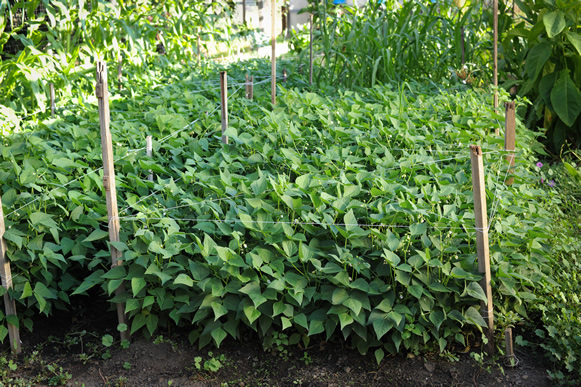Water Savings with GROW BIOINTENSIVE
Closely spaced bean plants conserve water: the shading reduces evaporation 13% to 63%. Since California is experiencing one of its most serious droughts in almost 500 years, we should all be thinking about how to conserve water in our gardens. Fortunately, Biointensive gardening has a lot to offer to the water-conscious gardener. For example, one of the most important things you can do to make your garden more water-efficient is to make sure your soil has sufficient organic matter, or "humus". A simple soil test can help you determine your soil organic matter (SOM) levels (Ecology Action uses www.growyour soil.org), and you can easily make compost to bring the SOM levels up. Another way to reduce water use through Biointensive gardening is to change how you space your plants. The "close offset spacing" used in Ecology Action's GROW BIOINTENSIVE method is a specific way of arranging plants in the garden bed to maximize growing efficiency and create a canopy of leaves to shade the soil and reduce water loss through evaporation. Properly spaced plants can reduce water usage by as much as 63%—meaning using as little as one-third the water you would normally use. A third way you can actively reduce the amount of water your garden uses is to make sure that the soil contains sufficient nutrients. When a soil is deficient in essential nutrients (N, P, K, Mg, Ca, S, Zn, Mn, Fe, Cu, Bo), the water in the soil contains less of those nutrients for the plants to use; therefore, the plants take up and transpire a larger quantity of water in an attempt to gather sufficient nutrients for their growth. Proper, balanced soil nutrients can reduce water usage by as much as 75%! But please, don't just add fertilizer to the soil without knowing what nutrients it needs—you can damage your soil and actually reduce fertility if you over-fertilize! A simple soil test can help you determine your soil's nutrient levels. Each of the water-saving techniques discussed above helps reduce the amount of water you use in the garden, depending of course on your soil type and the crops being grown. If you use all three of these techniques together, the effect is cumulative!
top | Newsletter Home | Article Index | Archive
|



